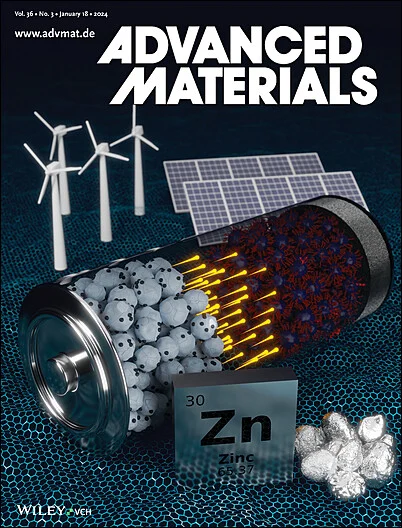Fingertip-Inspired Spatially Anisotropic Inductive Liquid Metal Sensors with Ultra-Wide Range, High Linearity and Exceptional Stability
IF 27.4
1区 材料科学
Q1 CHEMISTRY, MULTIDISCIPLINARY
引用次数: 0
Abstract
The advancement of robotic behavior and intelligence has led to an urgent demand for improving their sensitivity and interactive capabilities, which presents challenges in achieving multidimensional, wide-ranging, and reliable tactile sensing. Here an anisotropic inductive liquid metal sensor (AI-LMS) is introduced inspired by the human fingertip, which inherently possesses the capability to detect spatially multi-axis pressure with a wide sensing range, exceptional linearity, and signal stability. Additionally, it can detect very small pressures and responds swiftly to prescribed forces. Compared to resistive signals, inductive signals offer significant advantages. Further, integrated with a deep neural network model, the AI-LMS can decouple multi-axis pressures acting simultaneously upon it. Notably, the sensing range of Ecoflex and PDMS-based AI-LMS can be expanded by a factor of 4 and 9.5, respectively. For practical illustrations, a high-precision surface scanning reconstruction system is developed capable of capturing intricate details of 3D surface profiles. The utilization of biomimetic AI-LMS as robotic fingertips enables real-time discrimination of diverse delicate grasping behaviors across different fingers. The innovations and unique features in sensing mechanisms and structural design are expected to bring transformative changes and find extensive applications in the field of soft robotics.

随着机器人行为和智能的发展,人们迫切要求提高其灵敏度和交互能力,这给实现多维、大范围和可靠的触觉传感带来了挑战。这里介绍一种各向异性感应式液态金属传感器(AI-LMS),其灵感来源于人类的指尖,具有检测空间多轴压力的固有能力,感应范围广,线性度高,信号稳定。此外,它还能检测到非常小的压力,并对规定的力做出快速反应。与电阻信号相比,电感信号具有显著优势。此外,与深度神经网络模型集成后,AI-LMS 还能对同时作用在其上的多轴压力进行解耦。值得注意的是,基于 Ecoflex 和 PDMS 的 AI-LMS 的传感范围可分别扩大 4 倍和 9.5 倍。在实际应用中,我们开发了一种高精度表面扫描重建系统,能够捕捉三维表面轮廓的复杂细节。利用生物仿真人工智能-LMS 作为机器人指尖,可以实时分辨不同手指的各种精细抓握行为。传感机制和结构设计方面的创新和独特功能有望带来变革,并在软机器人领域得到广泛应用。
本文章由计算机程序翻译,如有差异,请以英文原文为准。
求助全文
约1分钟内获得全文
求助全文
来源期刊

Advanced Materials
工程技术-材料科学:综合
CiteScore
43.00
自引率
4.10%
发文量
2182
审稿时长
2 months
期刊介绍:
Advanced Materials, one of the world's most prestigious journals and the foundation of the Advanced portfolio, is the home of choice for best-in-class materials science for more than 30 years. Following this fast-growing and interdisciplinary field, we are considering and publishing the most important discoveries on any and all materials from materials scientists, chemists, physicists, engineers as well as health and life scientists and bringing you the latest results and trends in modern materials-related research every week.
 求助内容:
求助内容: 应助结果提醒方式:
应助结果提醒方式:


